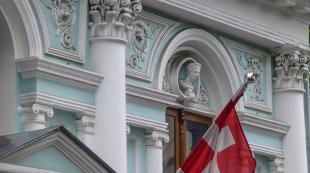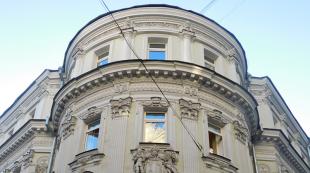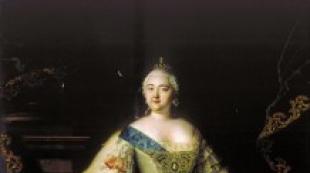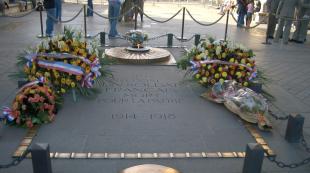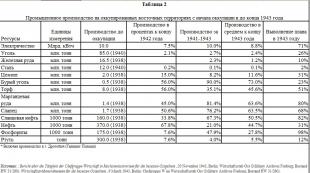Mansion V.V. Gudovich in Tsarskoye Selo (Pushkin). Domik Gudovicha (Vacation Home), Zelenogradsk (Russia) Deals
Looking at this representative building at Bryusov lane, 21, you would not guess that this is just a part of an impressive building that was previously located along the line of Tverskaya Street. But first things first.
The history of ownership can be traced back to the middle of the 17th century, when the owners were representatives of the princely estate of the Tyufyakins. Starting from 1754 and up to 1810, the city estate was owned by guards officers Kiselyovs.
The next owner was Prince Ivan Vasilievich Gudovich, who at that time held the post of Governor-General of Moscow and wished to buy his own property not far from the official residence - the governor's house (now - the building of the Moscow City Hall on).
Ivan Vasilievich held the rank of Field Marshal and was a holder of the Order of St. Andrew the First-Called. As a military man, he distinguished himself in several Russian-Turkish wars, and in the civil service he served as governor, first in the Ryazan and then in the Tambov province. Further - the governorship in Kyiv and Podolsk near Moscow, until in 1809 he became the governor-general of Moscow.
The count's wife was Praskovya Kirillovna - the daughter of the last Ukrainian hetman Kirill Grigoryevich Razumovsky.

The Gudovich couple had two sons and a daughter. Cyril and Andrei rose to the rank of major general, moreover, Andrei Ivanovich distinguished himself with his unit at Austerlitz, and after being seriously wounded at Shevardino, he left for civil service. Over time, he served in the rank of Chief Jägermeister at the Imperial Court, and then headed the Moscow nobility. Daughter Elizabeth became the wife of Ilya Ivanovich Lizogub, a colonel of the cavalry guard regiment and a musician.
In 1820, the count passed away and the estate with the manor house was inherited by his sons, each of whom was entitled to his own half.
Further history of Gudovich possession
In the period from 1826 to 1829, E.F. rented apartments on the property. Muravyov, whose sons Nikita and Alexander were Decembrists. Relatives and friends of the exiles came to her to get news from the places of imprisonment.

From 1847 to 1849, Alexander Sukhovo-Kobylin, who eventually became a very successful writer of his era, lived in a part of the house owned by Andrei Gudovich. His beloved Louise Simon-Demanche, a French milliner, who was killed right in the apartment in 1850, also rented an apartment there, which was a great shock to Alexander Vasilyevich.
In 1870 there was a change of ownership. The estate property was bought by a certain merchant Andreev, and the house itself became the property of a Little Russian landowner and a representative of an old Cossack family Andrei Mikhailovich Miklashevsky, the owner of a porcelain manufactory, who in 1898 ordered a project for the reconstruction of the building to the architect. It was then that the facade plane received a new decor, and the semi-rotunda in the corner part was decorated with the family coat of arms of the Miklashevsky family, on which their motto “IN DEO SPES MEA” was written, which means “My hope is in God”.

In 1900, Countess Alexandra Andreevna Olsufieva became the owner - the owner's own daughter, to whom the possessions were inherited. Since 1911, she was the lady of state of the Russian Empress Alexandra Feodorovna.
The history of the house of this period is associated with the name of the future commander Georgy Konstantinovich Zhukov. The fact is that it was here that his uncle Mikhail Artemyevich Pilikhin lodged and kept a furrier workshop, with whom he was an apprentice.
Before the revolution of 1917, the house housed various drinking establishments, as well as a cinema (cinema) "Mignon".
Under Soviet rule, at the end of the 1930s, Tverskaya Street was reconstructed in Moscow, in connection with which the former half of the house, which once belonged to Kirill Gudovich, was destroyed, but the second - Andrei Ivanovich Gudovich - was moved on rails deep into Bryusov Lane.
Later, the building housed the USSR State Committee for Science and Technology. Today, the house in Bryusov Lane, 21 is occupied by the Ministry of the Russian Federation for Science and Education.
In Bryusov Lane you can see many interesting buildings with their own history. One of these mansions is the Gudovich House. Much can be said about the owner of this house, General-in-Chief Ivan Gudovich, the hero of the Russian-Turkish wars and the Moscow governor, and about the famous residents of this house. The story of the famous playwright, industrialist and brilliant cavalier Sukhov-Kobylin, who was accused of murdering his mistress, occupied all of Moscow for a long time.
House number 21 in Bryusov Lane did not always stand in the place where it is now. During the Stalinist reconstruction, when Tverskaya Street was being expanded, it was moved to a side street without damaging it. Of course, the engineers hardly thought about the history of the building. They were tackling the unique challenge of moving the house, along with the basements, up the street. And a detective story is connected with this building, which stirred up all of Moscow in the middle of the 19th century. This building belonged to Ivan Vasilyevich Gudovich, who was the governor of Moscow before the Patriotic War of 1812. The Russian General Field Marshal, a participant in the Russian-Turkish wars, died in 1820. He left two sons Andrei and Cyril. Kirill Ivanovich participated in the battle of Borodino at the Shevardinsky redoubt, was wounded. After the war, for about 10 years he served as the leader of the Moscow nobility. After the death of their father, the sons divided the building in half. In 1826-1829. the mother of the Decembrists Nikita and Alexander Muravyov lived here. Relatives and friends of the Decembrists gathered at her place, hoping to get at least some news about their relatives and friends.
In 1847, part of the house was handed over to Alexander Sukhovo-Kobylin. A handsome man, a rich man, a social lion, he settled his French mistress Louise Simon-Demanche there. Sukhovo-Kobylin met her in France and gave her money for a trip to Russia. Their romance lasted quite a long time, but in 1850 Louise's body was found abandoned at the Vagankovsky cemetery. Sukhovo-Kobylin was suspected of her murder, an investigation began. Servants and possible witnesses were interrogated. The evidence was very conflicting. Now the janitor confessed that he had killed the mistress, then they said that this was Sukhovo-Kobylin. Servants frankly extorted money for the necessary testimony. Sukhovo-Kobylin was either imprisoned or released. In prison, he wrote his famous play "Krechinsky's Wedding". This play was staged in all repertory theaters. She was staged more than once in Soviet times. The murder investigation lasted 7 years and the writer was acquitted. The culprits were never found. Only one quarter warden was convicted, who was exiled to Siberia for torture of witnesses. The mystery of Louise's murder has not yet been solved, although there are several possible versions.
The modern appearance of the building appeared at the end of the 19th century. It was rebuilt by the architect Sergei Rodionov. The building was then owned by the manufacturer Andrey Miklashevsky. On the facade is its coat of arms with the motto "In God is my hope" (In Deo spes mea).
Subsequently, since 1900, the house was owned by the daughter of Miklashevsky, the lady of state of Empress Alexandra Feodorovna, Countess Olsufyeva. This house is associated with the Soviet commander Georgy Zhukov. His uncle Mikhail Pilikhin lived in this house and kept a furrier workshop. The future commander worked as his apprentice.
Until 1917, the house housed various drinking establishments, the Mignon cinematograph. In the future, the State Committee for Science and Technology was located here, and now it is occupied by the Ministry of Education of the Russian Federation.
A valiant warrior who did not bow to the enemy under bullets, Ivan Vasilyevich Gudovich was remembered by his contemporaries for his strange quirks. (now they would say "fad"). He didn't like glasses. The sight of a man with glasses infuriated him and everyone tried not to get into his eyes with glasses. Even at a party, he could make any person take off his glasses.
He also could not stand three horses. And if someone still came to him in a troika, then the troika was unharnessed outside the gate and one of the horses was tied behind.
Registered users can take part in writing an article and receive a reward.
One of the representative houses of Bryusov Lane with magnificent stucco and coat of arms is only a part of the once large building that overlooked Tverskaya Street at an angle. At the beginning of the XIX century. the house was in the possession of the sons of Count IV Gudovich.
Field Marshal General, holder of the Order of St. Andrew the First-Called, who distinguished himself in the Russian-Turkish wars, Count Ivan Vasilyevich Gudovich, who throughout his life held the positions of viceroy of the Ryazan and Tambov provinces, governor of Kyiv and Podolsk, was in 1809 appointed military governor of Moscow. In 1810, the new governor acquired a manor near his official residence - the governor's house on Tverskaya Street (now the building of the Moscow City Hall).
From the second half of the 17th century, these were the possessions of the princes Tyufyakins, from 1754 to 1810 the site belonged to the officers of the guard regiments Kiselev.
Ivan Vasilyevich was married to the daughter of the last hetman of Ukraine K.G. Razumovsky Praskovya Kirillovna, having received a rich dowry for her. The couple had two sons - both rose to the rank of major general - Kirill Ivanovich (1777-1856) and Andrei Ivanovich (1782-1867). The latter, who distinguished himself with his regiment in the battles of Austerlitz and was seriously wounded in the battle of the village of Shevardino, later served as Chief Jagermeister of the Imperial Court and for over 10 years was the leader of the Moscow nobility. Gudovich's daughter Elizaveta Ivanovna was married to the colonel of the cavalry guard regiment I.I. Lizogub.
After the death of the count in 1820, his sons, Andrei and Kirill, divided his house on the corner of Tverskaya Street, since then each half of the house began to live its own life.
In 1826 - 1829, E. F. Muravyov, the mother of the Decembrists Nikita and Alexander Muravyov, rented an apartment in the Gudovich house. Friends and close relatives of the Decembrists gathered and received information about the exiles here.
In 1847-1849. in the house on the half of Count A.I. Gudovich lived a representative of an ancient noble family, the future famous writer (1817-1903). He himself occupied one apartment, the other was occupied by his beloved, a former French milliner, Louise Simon-Demanche. In 1850, a crime was committed in the house, which became central to the fate of Sukhovo-Kobylin - the murder of Louise.
In the 1870s, part of the household passed to the merchant Andreev. The house of the Gudovichs was acquired by the headquarters captain Andrei Mikhailovich Miklashevsky. In 1898, according to the project of the architect S.K. Rodionov, the house was re-finished on the facade, and then the Miklashevsky family coat of arms appeared on the corner semi-rotunda with the motto “IN DEO SPES MEA” (“my hope is in God”) and the initials of the then owner of the house "AM" - Andrei Mikhailovich Miklashevsky.
In 1900, Miklashevsky's daughter, Countess A. A. Olsufyeva, inherited the house. In the 1910s, her house housed the apartment and furrier workshop of M.A. Pilikhina - Uncle G.K. Zhukov (the future marshal served as his apprentice for several years). Later, the house had furnished rooms, the Mignon cinematograph, drinking establishments.
In the late 1930s, in connection with the expansion of Tverskaya Street, part of the house was dismantled, and part was moved on rails deep into Bryusov Lane. As a result of the movement, only a half, belonging to Andrei Ivanovich Gudovich, was preserved. The property of Kirill Ivanovich Gudovich was lost. In Soviet times, the USSR State Committee for Science and Technology was located in the Gudovich-Miklashevsky house. Currently, the building houses the Ministry of Science and Education of the Russian Federation.
I can't imagine my life without the sea, sports, books, my friends and family. I would like that among the guests of my house there were people who appreciate the beauty of nature, creativity, good music, strong friendship and new life decisions. The basic principles of life are to live honestly and with inspiration. Our company "House by the Sea" has existed for more than 3 years. Dozens of apartments and houses, hundreds of grateful reviews. We additionally provide our guests with information on excursions, transfers, car, bicycle and electric scooter rentals. With us, your vacation will be safe and comfortable!
Property Information
It will be good for couples in love, families with children, artists, as well as people who come to Zelenogradsk on business to relax in the house. The house is located 150 meters, 257 steps, three minutes walk from the sea. Gudovich's house is not just a "where to stay" place. This is a space for your inspiration, for relaxation in harmony with yourself and the world around you. This is a harbor where everyone returns to their true self, where you can move away from the daily hustle and bustle. In a house built by your own hands, you will have the desire to write poetry, draw while looking out of a large window overlooking the sea, read books while sitting in a comfortable leather chair, relax and unwind to the sounds of deep velvet music.
Area Information
Zelenogradsk has retained the charm of those times when it was called the "Royal" resort in East Prussia. The city is very quiet, a little stretched along the beach, not on a steep coast, like Svetlogorsk, but on a plain, with convenient access to the sea, open, and therefore and more sunny.Even in early spring you are provided with a wonderful rest.The sea is still cold, but the so-called "frying pans" stretch along the coast - sandy glades between dunes, overgrown with small shrubs and trees, which protect these glades from the wind.You can perfectly sunbathe on them "The sea with a sandy bottom warms up faster than in Svetlogorsk and is always a few degrees warmer. Zelenogradsk is also the city that gives rise to the unique Curonian Spit National Park. Therefore, walking along the beach, you can easily reach the reserve of Russia.
Rustam Rakhmatullin
Recently, Moskomnasledie has refused to accept several "statements about the discovery of heritage objects" from the public (so in the law). The fact is that in December last year, the Moscow government adopted a new version of Decree 510 on the city register of immovable cultural heritage. Clause 6.4 has become new, stating that objects that the Moscow Heritage Committee has already refused in primary accounting are not subject to re-consideration.
The addresses of Tropinin, Odoevsky, Sukhovo-Kobylin remain without protection.
The new version of the decree does not comply with the law on heritage protection, since the discovery of monuments is always the discovery of new circumstances: an outwardly unremarkable house may turn out to be chambers of the 17th century or the dwelling of a great poet.
Crime scene: Gudovich's house

In Bryusov Lane, 21, there is a magnificent house with a noble coat of arms on the corner semi-rotunda. Once the semi-rotunda faced the corner of Tverskaya Street, but in 1941 the house moved to the side street. It is unlikely that the monument was dear to Stalin's reenactors; It was interesting to try out an engineering solution - to move the building up the terrain, and along with the basements. One way or another, the house of Count Gudovich was preserved.
Ivan Vasilyevich Gudovich was the governor of Moscow on the eve of the war of 1812. The conqueror of Anapa, Derbent, Baku and Khadzhibey (Odessa), he settled next to the state governor's residence - the current city hall, in a rich house of the 18th century. Forty years later, Gudovich's son handed over part of the house to Alexander Sukhovo-Kobylin. The future playwright settled here his beloved Louise Simon-Demanche. The accusation of Kobylin in the murder of Louise is one of the most tragic love stories of Moscow in the era of romanticism. After the city government destroyed the writer's own house on thirteen years ago, Gudovich's house remained the main Kobylin memorial. The police believed that the murder had taken place on Strastnoy until four of Louise's servants confessed to the crime. They called the motive the cruelty of the lady, and the place of the murder - the house of Gudovich. The case has not yet been resolved. The coat of arms with the motto "In Deo spes mea" ("In God is my hope") and the appearance of the manor house (architect Sergei Rodionov) date back to the end of the 19th century, when the owner was the Little Russian nobleman and industrialist Andrei Miklashevsky.
Surprisingly, Gudovich's house does not have the status of a monument. Six months ago, Professor Kirill Novoselsky sent an application for protection to the Moscow Heritage Committee. From the answer that came in June, it follows that the house had already been declared earlier and considered by the committee's expert council in 2003. The decision was negative, and a retrial is not possible under the 510th ruling. I wonder who and how formulated the previous application, who and what said at the expert council, so that the ancient count's house, the writer's memorial could not become a monument? It is only known that the old application did not include courtyard service buildings. The new application created a paradoxical situation: these buildings are recognized as declared monuments, and the main house remains a “historically valuable city-forming object”, that is, nothing.
Tropinin window overlooking the Kremlin

In 2009, Marina Dementieva, a member of Arch Supervision, declared another miraculously forgotten address for protection - the house of Vasily Tropinin at Lenivka, 3. The famous artist moved here in 1832, when his family was released from serfdom, and lived here for more than twenty years. Hundreds of portraits of Muscovites are painted here. On the third floor, one window is scattered and stands out in size. It is believed that outside the window is Tropinin's workshop. That it is at this window overlooking the Kremlin that the artist is standing on his textbook self-portrait. In general, Tropinin often seated the characters at the workshop window. So, in the portrait of Protasyev, Pashkov’s house and the church of Nikola Streletsky are visible outside the window, and in the portrait of his wife, the Trinity Tower of the Kremlin. The landscape of this part of Moscow seems to wrap around Tropinin's house.
This application has also been rejected. And again the question: how was someone's old application formulated and discussed so that Tropinin's house could not become a monument?
Meanwhile, the house is settled and empty. Unlike the Gudovich house, occupied by the Ministry of Education and Science, there is someone's investment interest on Lenivka.
Protected status remains a subject of manipulation, and the new version of the 510th resolution was invented to facilitate the hard work of manipulators.
Appendix: Odoevsky's estate and others

Over the past six months, social activists have received refusals at a dozen addresses. Among them:
- the manor house of the princes Odoevsky on Petrovka, 26, building 5, in which, according to some information, the last of the Odoevsky family, the writer Vladimir Fedorovich, was born (“Russian Nights”, “Town in a Snuffbox”). In 1812 the house was the residence of the Napoleonic marshal Berthier;
- with mosaics by the famous French architect Eduard Nyerman in the interior of the store - here, on Nikolskaya, 12, a radical reconstruction is underway;
